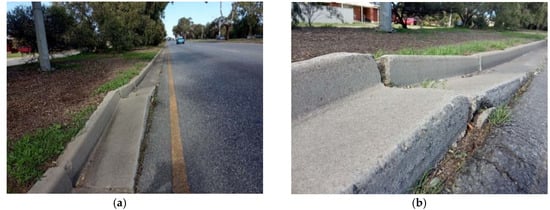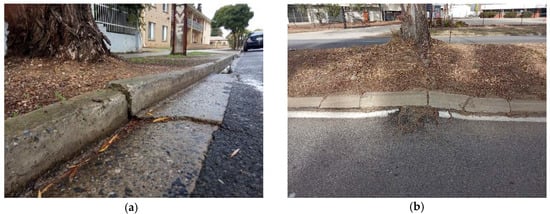
| Version | Summary | Created by | Modification | Content Size | Created at | Operation |
|---|---|---|---|---|---|---|
| 1 | Hasan Momotaz | + 1159 word(s) | 1159 | 2022-01-24 07:36:56 | | | |
| 2 | Nora Tang | Meta information modification | 1159 | 2022-02-17 03:58:19 | | | | |
| 3 | Nora Tang | Meta information modification | 1159 | 2022-02-21 06:51:49 | | | | |
| 4 | Nora Tang | Meta information modification | 1159 | 2022-02-21 06:52:35 | | | | |
| 5 | Lindsay Dong | Meta information modification | 1159 | 2022-03-28 06:11:00 | | |
Video Upload Options
Concrete kerbs can be prepared by precast and cast in situ methods. The precast concrete kerbs can be manufactured by conventional (using a vibrator), dry-pressed and wet-pressed methods and can be installed in almost all weather conditions. Possible rainfall, temperatures and sunlight hours are considered in casting in situ kerbs, and they are more labour-intensive compared to the precast variations. However, cast in situ kerb can better handle sudden changes of direction. There is no study found comparing different aspects of in situ casting and precast kerb. Both types of concrete kerb are suggested for construction by all authorities, such as the Austroads and AASHTO. The precast kerbs require manual placement and have been a major source of workplace injury in the United Kingdom. Past studies have suggested that the use of special lifting equipment (such as vacuum lifters, lifting clamps or stone magnets), reduction in kerb section length, reduction in kerb foundation depth, use of a lightweight or hollow concrete section or other lightweight materials, such as polymer, can reduce the likelihood of such workplace injuries and may also lead to quicker construction as well as better construction quality.
1. Base Preparation
2. Additional Considerations for Construction on Expansive Subgrade

3. Consideration for Mitigation of Tree Root Migration Effect
-
Tree-related variables, such as species, height, trunk diameter, growth rate, extraction capacity, tree roots properties (radius, depth, lateral spread, trajectory), mature age, wilting point, watering frequency, transpiration rate and distance from the kerb, should be considered;
-
Soil-related variables, such as particle size, moisture content, reactivity, compaction, compacted depth and groundwater level, should be considered;
-
Weather-related variables, such as climate, temperature and rainfall, should be considered;
-
Drainage condition is influencing factors for kerb and pavement damage.

-
Compacted soil is more resistant to tree root growth compared to uncompacted natural soil [32].
References
- City of Salisbury. City of Salisbury Infrastructure Guidelines-2019; City of Salisbury: Adelaide, Australia, 2019. Available online: https://www.salisbury.sa.gov.au/assets/files/sharedassets/public/website_digitalpublications/development_-_development_engineering/city_of_salisbury_infrastructure_guidelines_march_2019.pdf (accessed on 10 January 2022).
- Standards Australia. Concrete Kerbs and Channels (Gutters)—Manually or Machine Placed, AS 2876—2000; Standards Australia: Sydney Australia, 2000; p. 20.
- British Standard. Pavements Constructed with Clay, Natural Stone or Concrete Pavers—Part 6: Code of Practice for Laying Natural Stone, Precast Concrete and Clay Kerb Units, BS 7533-6:1999; British Standard: London, UK, 1999; p. 14.
- Province of Manitoba. Specifications for Concrete Curbing; Manitoba Infrastructure and Transportation: Steinbech, MB, Canada, 2013. Available online: https://www.gov.mb.ca/mit/contracts/pdf/manual/860i.pdf (accessed on 10 January 2022).
- Austroads. Guide to Pavement Technology Part 2: Pavement Structural Design; Austroads: Sydney, Australia, 2017; p. 295.
- Elarabi, H. Prediction of Expansive Soils Behaviour. In Proceedings of the International Conference on Geotechnical Engineering, January 2010; Available online: https://www.researchgate.net/profile/Hussein-Elarabi/publication/270817068_Prediction_of_Expansive_Soils_Behaviour/links/54b518120cf2318f0f971d34/Prediction-of-Expansive-Soils-Behaviour.pdf (accessed on 10 January 2022).
- Evans, R.; McManus, K. Construction of vertical moisture barriers to reduce expansive soil subgrade movement. Transp. Res. Rec. 1999, 1652, 108–112.
- Mokhtari, M.; Dehghani, M. Swell-shrink behavior of expansive soils, damage and control. Electron. J. Geotech. Eng. 2012, 17, 2673–2682.
- Fityus, S.G.; Cameron, D.A.; Walsh, P.F. The shrink swell test. Geotech. Test. J. 2005, 28, 92–101.
- McManus, K.; Brown, R. Rehabilitation of Damaged Houses Founded on Expansive Soils Using Moisture Recharge. In Proceedings of the 7th Australia New Zealand Conference on Geomechanics: Geomechanics in a Changing World, Adelaide, Australia, 1–5 July 1996; p. 375.
- Gordon, R.; Waters, T. A case study of performance of pavements on an expansive soil subgrade. In Proceedings of the Fifth International Conference on Expansive Soils, Adelaide, Australia, 21–23 May 1984; p. 263.
- Puppala, A.J.; Pedarla, A. Innovative ground improvement techniques for expansive soils. Innov. Infrastruct. Solut. 2017, 2, 24.
- Cameron, D.; Beal, N. Estimation of foundation movement and design of footing systems on reactive soils for the effects of trees. Aust. Geomech. 2011, 46, 97.
- Johnson, T. Trees, Stormwater, Soil and Civil Infrastructure: Synergies Towards Sustainable Urban Design for a Changing Climate. Ph.D. Thesis, University of South Australia, Adelaide, Australia, 2017.
- Li, J.; Zhou, Y.; Guo, L.; Tokhi, H. The establishment of a field site for reactive soil and tree monitoring in Melbourne. Aust. Geomech. J. 2014, 49, 63–72.
- Stewart, M.; Sands, R. Soil movement and water potentials in trees growing in expansive clay soils. Arboric. J. 1998, 22, 343–357.
- Sun, X.; Li, J.; Cameron, D.; Zhou, A. Field monitoring and assessment of the impact of a large eucalypt on soil desiccation. Acta Geotech. 2021, 1–14.
- Burger, D.W.; Taylor, Z. Selection and propagation of deep-rooted ornamental trees for urban environments. In Proceedings of the Combined Proceedings-International Plant Propagators Society; pp. 622–631. Available online: https://slosson.ucdavis.edu/newsletters/Burger_199829079.pdf (accessed on 10 January 2022).
- Costello, L.; McPherson, E.; Burger, D.; Perry, E.; Kelley, D. Strategies to reduce infrastructure damage by tree roots: A symposium for researchers and practitioners. In Proceedings of the a Symposium, Davis, CA, USA, 31 March–1 April 2000; University of California: Berkeley, CA, USA, 2000. Available online: https://slosson.ucdavis.edu/newsletters/Costello_200129024.pdf (accessed on 10 January 2022).
- Day, R.W. Damage of structures due to tree roots. J. Perform. Constr. Facil. 1991, 5, 200–207.
- Grabosky, J.; Bassuk, N. A new urban tree soil to safely increase rooting volumes under sidewalks. J. Arboric. 1995, 21, 187.
- Grabosky, J.; Bassuk, N. Increase streettree rooting volumes. J. Arboric. 1996, 22, 255.
- McPherson, E.G. Expenditures associated with conflicts between street tree root growth and hardscape in California. J. Arboric. 2000, 26, 289–297.
- McPherson, E.G.; Peper, P.P. Costs of street tree damage to infrastructure. Arboric. J. 1996, 20, 143–160.
- Sydnor, T.D.; Gamstetter, D.; Nichols, J.; Bishop, B.; Favorite, J.; Blazer, C.; Turpin, L. Trees are not the root of sidewalk problems. J. Arboric. 2000, 26, 20–29.
- Randrup, T.; McPherson, E.; Costello, L. A review of tree root conflicts with sidewalks, curbs, and roads. Urban Ecosyst. 2001, 5, 209–225.
- O’Malley, A.; Cameron, D. The Influence of Trees on Soil Moisture, Dwellings and Pavements in an Urban Environment; Local Government Association and City of Salisbury Council: Adelaide, Australia, 2005.
- Pile, K.C. Urban Tree Planting and the Risk of Pavement Damage; Institution of Engineers Australia: Barton, Australia, 1981; pp. 196–199.
- Wagar, J.A.; Barker, P.A. Tree root damage to sidewalks and curbs. J. Arboric. 1983, 9, 177–181.
- Francis, J.K.; Parresol, B.R.; de Patino, J.M. Probability of damage to sidewalks and curbs by street trees in the tropics. J. Arboric. 1996, 22, 193–197.
- McManus, K.; Brown, R. The Performance of Light Structures founded in Expansive Clays following Active Moisture Recharge. In Proceedings of the 8th Australia New Zealand Conference on Geomechanics, Consolidating Knowledge, Barton, Australia, 1 January 1999; p. 201.
- Lucke, T.; Beecham, S. An infiltration approach to reducing pavement damage by street trees. Sci. Total Environ. 2019, 671, 94–100.
- Johnson, T.; Moore, G.; Cameron, D.; Brien, C. An investigation of tree growth in permeable paving. Urban For. Urban Green. 2019, 43, 126374.
- Hilbert, D.R.; North, E.A.; Hauer, R.J.; Koeser, A.K.; McLean, D.C.; Northrop, R.J.; Andreu, M.; Parbs, S. Predicting trunk flare diameter to prevent tree damage to infrastructure. Urban For. Urban Green. 2020, 49, 126645.
- Rahman, M.M.; Hora, R.N.; Ahenkorah, I.; Beecham, S.; Karim, M.R.; Iqbal, A. State-of-the-Art Review of Microbial-Induced Calcite Precipitation and Its Sustainability in Engineering Applications. Sustainability 2020, 12, 6281.
- Ahenkorah, I.; Rahman, M.M.; Karim, M.R.; Beecham, S.; Saint, C. A Review of Enzyme Induced Carbonate Precipitation (EICP): The Role of Enzyme Kinetics. Sustain. Chem. 2021, 2, 92–114.
- Ahenkorah, I.; Rahman, M.M.; Karim, M.R.; Teasdale, P.R. A comparison of mechanical responses for microbial- and enzyme-induced cemented sand. Géotechnique Lett. 2020, 10, 559–567.




